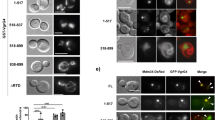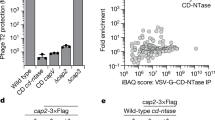Abstract
Cell-autonomous immunity relies on the ubiquitin coat surrounding cytosol-invading bacteria functioning as an ‘eat-me’ signal for xenophagy. The origin, composition and precise mode of action of the ubiquitin coat remain incompletely understood. Here, by studying Salmonella Typhimurium, we show that the E3 ligase LUBAC generates linear (M1-linked) polyubiquitin patches in the ubiquitin coat, which serve as antibacterial and pro-inflammatory signalling platforms. LUBAC is recruited via its subunit HOIP to bacterial surfaces that are no longer shielded by host membranes and are already displaying ubiquitin, suggesting that LUBAC amplifies and refashions the ubiquitin coat. LUBAC-synthesized polyubiquitin recruits Optineurin and Nemo for xenophagy and local activation of NF-κB, respectively, which independently restrict bacterial proliferation. In contrast, the professional cytosol-dwelling Shigella flexneri escapes from LUBAC-mediated restriction through the antagonizing effects of the effector E3 ligase IpaH1.4 on deposition of M1-linked polyubiquitin and subsequent recruitment of Nemo and Optineurin. We conclude that LUBAC-synthesized M1-linked ubiquitin transforms bacterial surfaces into signalling platforms for antibacterial immunity reminiscent of antiviral assemblies on mitochondria.
This is a preview of subscription content, access via your institution
Access options
Access Nature and 54 other Nature Portfolio journals
Get Nature+, our best-value online-access subscription
$29.99 / 30 days
cancel any time
Subscribe to this journal
Receive 12 digital issues and online access to articles
$119.00 per year
only $9.92 per issue
Buy this article
- Purchase on SpringerLink
- Instant access to full article PDF
Prices may be subject to local taxes which are calculated during checkout




Similar content being viewed by others
References
Deretic, V., Saitoh, T. & Akira, S. Autophagy in infection, inflammation and immunity. Nat. Rev. Immunol. 13, 722–737 (2013).
Cadwell, K. et al. A key role for autophagy and the autophagy gene Atg16l1 in mouse and human intestinal Paneth cells. Nature 456, 259–263 (2008).
Heath, R. J. et al. RNF166 determines recruitment of adaptor proteins during antibacterial autophagy. Cell Rep. 17, 2183–2194 (2016).
Manzanillo, P. S. et al. The ubiquitin ligase parkin mediates resistance to intracellular pathogens. Nature 501, 512–516 (2013).
Franco, L. H. et al. The ubiquitin ligase Smurf1 functions in selective autophagy of Mycobacterium tuberculosis and anti-tuberculous host defense. Cell Host Microbe 21, 59–72 (2017).
Perrin, A., Jiang, X., Birmingham, C., So, N. & Brumell, J. Recognition of bacteria in the cytosol of mammalian cells by the ubiquitin system. Curr. Biol. 14, 806–811 (2004).
Thurston, T. L. M., Wandel, M. P., von Muhlinen, N., Foeglein, A. & Randow, F. Galectin 8 targets damaged vesicles for autophagy to defend cells against bacterial invasion. Nature 482, 414–418 (2012).
Thurston, T. L. M., Ryzhakov, G., Bloor, S., Muhlinen von, N. & Randow, F. The TBK1 adaptor and autophagy receptor NDP52 restricts the proliferation of ubiquitin-coated bacteria. Nat. Immunol. 10, 1215–1221 (2009).
Wild, P. et al. Phosphorylation of the autophagy receptor optineurin restricts Salmonella growth. Science 333, 228–233 (2011).
Boyle, K. B. & Randow, F. The role of ‘eat-me’ signals and autophagy cargo receptors in innate immunity. Curr. Opin. Microbiol. 16, 339–348 (2013).
Cemma, M., Kim, P. K. & Brumell, J. H. The ubiquitin-binding adaptor proteins p62/SQSTM1 and NDP52 are recruited independently to bacteria-associated microdomains to target Salmonella to the autophagy pathway. Autophagy 7, 341–345 (2011).
Kirisako, T. et al. A ubiquitin ligase complex assembles linear polyubiquitin chains. EMBO J. 25, 4877–4887 (2006).
Ikeda, F. et al. SHARPIN forms a linear ubiquitin ligase complex regulating NF-κB activity and apoptosis. Nature 471, 637–641 (2011).
Tokunaga, F. et al. SHARPIN is a component of the NF-κB-activating linear ubiquitin chain assembly complex. Nature 471, 633–636 (2011).
Gerlach, B. et al. Linear ubiquitination prevents inflammation and regulates immune signalling. Nature 471, 591–596 (2011).
Fiskin, E., Bionda, T., Dikic, I. & Behrends, C. Global analysis of host and bacterial ubiquitinome in response to Salmonella typhimurium infection. Mol. Cell 62, 967–981 (2016).
Collins, C. A. et al. Atg5-independent sequestration of ubiquitinated mycobacteria. PLoS Pathogens 5, e1000430 (2009).
Fujita, N. et al. Recruitment of the autophagic machinery to endosomes during infection is mediated by ubiquitin. J. Cell Biol. 203, 115–128 (2013).
Fujita, H. et al. Mechanism underlying I B kinase activation mediated by the linear ubiquitin chain assembly complex. Mol. Cell Biol. 34, 1322–1335 (2014).
Stieglitz, B. et al. Structural basis for ligase-specific conjugation of linear ubiquitin chains by HOIP. Nature 503, 422–426 (2013).
Haas, T. L. et al. Recruitment of the linear ubiquitin chain assembly complex stabilizes the TNF-R1 signaling complex and is required for TNF-mediated gene induction. Mol. Cell 36, 831–844 (2009).
Sato, Y. et al. Specific recognition of linear ubiquitin chains by the Npl4 zinc finger (NZF) domain of the HOIL-1L subunit of the linear ubiquitin chain assembly complex. Proc. Natl Acad. Sci. USA 108, 20520–20525 (2011).
Swatek, K. N. & Komander, D. Ubiquitin modifications. Cell Res. 26, 399–422 (2016).
Rahighi, S. et al. Specific recognition of linear ubiquitin chains by NEMO is important for NF-κB activation. Cell 136, 1098–1109 (2009).
Bloor, S. et al. Signal processing by its coil zipper domain activates IKK gamma. Proc. Natl Acad. Sci. USA 105, 1279–1284 (2008).
Kageyama, S. et al. The LC3 recruitment mechanism is separate from Atg9L1-dependent membrane formation in the autophagic response against Salmonella. Mol. Biol. Cell 22, 2290–2300 (2011).
Muhlinen von, N. et al. LC3C, bound selectively by a noncanonical LIR motif in NDP52, is required for antibacterial autophagy. Mol. Cell 48, 329–342 (2012).
Li, S. et al. Sterical hindrance promotes selectivity of the autophagy cargo receptor NDP52 for the danger receptor galectin-8 in antibacterial autophagy. Sci. Signal. 6, ra9 (2013).
Ichimura, Y. et al. Structural basis for sorting mechanism of p62 in selective autophagy. J. Biol. Chem. 283, 22847–22857 (2008).
de Jong, M. F., Liu, Z., Chen, D. & Alto, N. M. Shigella flexneri suppresses NF-κB activation by inhibiting linear ubiquitin chain ligation. Nat. Microbiol. 1, 16084 (2016).
Caruso, R., Warner, N., Inohara, N. & Núñez, G. NOD1 and NOD2: signaling, host defense, and inflammatory disease. Immunity 41, 898–908 (2014).
Huett, A. et al. The LRR and RING domain protein LRSAM1 is an E3 ligase crucial for ubiquitin-dependent autophagy of intracellular Salmonella typhimurium. Cell Host Microbe 12, 778–790 (2012).
van Wijk, S. J. L. et al. Fluorescence-based sensors to monitor localization and functions of linear and K63-linked ubiquitin chains in cells. Mol. Cell 47, 797–809 (2012).
Randow, F. & Youle, R. J. Self and nonself: how autophagy targets mitochondria and bacteria. Cell Host Microbe 15, 403–411 (2014).
Wu, J. & Chen, Z. J. Innate immune sensing and signaling of cytosolic nucleic acids. Annu. Rev. Immunol. 32, 461–488 (2014).
Randow, F. & Sale, J. E. Retroviral transduction of DT40. Subcell. Biochem. 40, 383–386 (2006).
Kuma, A. et al. The role of autophagy during the early neonatal starvation period. Nature 432, 1032–1036 (2004).
Michel, M. A. et al. Assembly and specific recognition of k29- and k33-linked polyubiquitin. Mol. Cell 58, 95–109 (2015).
Acknowledgements
This work was supported by the Medical Research Council (U105170648 to F.R. and U105192732 to D.K.) and the Wellcome Trust (WT104752MA) and Boehringer Ingelheim Fonds PhD fellowships (to C.P. and M.A.M.). The authors thank N. Mizushima for ATG5−/− MEFs, H. Walczack for Sharpincpdm MEFs, M. Gyrd-Hansen for RipK2−/− and HOIP−/− HCT116s and E. Werner for technical help.
Author information
Authors and Affiliations
Contributions
J.N. performed and analysed all experiments, except those in Fig. 2e (A.v.d.M., D.K.), Fig. 3h (C.P.), Fig. 3i (C.P., J.N.), Supplementary Fig. 1 (A.M., D.K.), Supplementary Fig. 2a (A.M.), Supplementary Fig. 6 (A.M.) and Supplementary Fig. 7 (A.M., M.A.M., D.K.). J.N. and F.R. wrote the manuscript.
Corresponding author
Ethics declarations
Competing interests
The authors declare no competing financial interests.
Supplementary information
Supplementary Information
Supplementary Figures 1–15. (PDF 10571 kb)
Supplementary Video 1
LUBAC is recruited after membrane damage and remains associated with daughter bacteria. Live imaging on a confocal spinning disk microscope of MEFs co-expressing mCherry:Galectin-8, GFP:HOIL-1, Flag:HOIP and Flag:Sharpin, infected with BFP-expressing S.Typhimurium and imaged every 2 min. Supplement to Fig. 2g. Scale bar, 7μm. (MOV 890 kb)
Rights and permissions
About this article
Cite this article
Noad, J., von der Malsburg, A., Pathe, C. et al. LUBAC-synthesized linear ubiquitin chains restrict cytosol-invading bacteria by activating autophagy and NF-κB. Nat Microbiol 2, 17063 (2017). https://doi.org/10.1038/nmicrobiol.2017.63
Received:
Accepted:
Published:
DOI: https://doi.org/10.1038/nmicrobiol.2017.63
This article is cited by
-
Mitochondrial outer membrane integrity regulates a ubiquitin-dependent and NF-κB-mediated inflammatory response
The EMBO Journal (2024)
-
Mitochondria and cell death
Nature Cell Biology (2024)
-
Control of mitophagy initiation and progression by the TBK1 adaptors NAP1 and SINTBAD
Nature Structural & Molecular Biology (2024)
-
Systematic HOIP interactome profiling reveals critical roles of linear ubiquitination in tissue homeostasis
Nature Communications (2024)
-
The great escape: a Shigella effector unlocks the septin cage
Nature Communications (2024)



